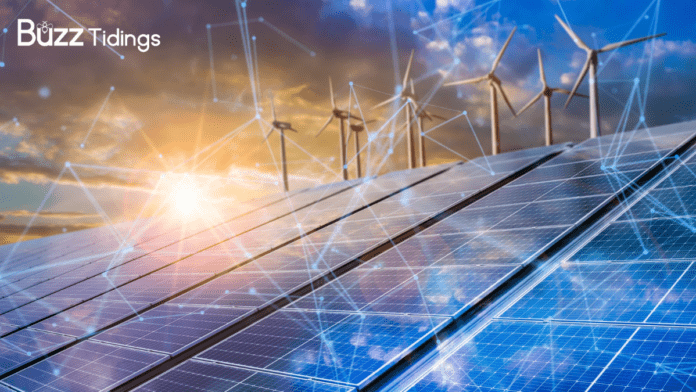Role of Technology in Advancing Renewable Energy: In the pursuit of a sustainable and greener future, technology has emerged as a powerful catalyst, driving innovation and efficiency in the renewable energy sector. The intersection of technology and renewable energy is transforming the way we generate, store, and distribute clean power. This article explores the pivotal role of technology in advancing renewable energy solutions, fostering a transition towards a more sustainable energy landscape.
Solar Photovoltaic (PV) Technology:
- Solar energy, harnessed through photovoltaic cells, has witnessed remarkable advancements. Technological breakthroughs in solar PV technology have significantly improved efficiency, making solar panels more cost-effective and accessible. Innovations such as thin-film solar cells, bifacial panels, and solar tracking systems have enhanced energy capture and utilization.
Energy Storage Solutions:
- The intermittent nature of renewable energy sources, such as solar and wind, necessitates effective energy storage solutions. Technology has played a pivotal role in the development of advanced energy storage systems, including lithium-ion batteries, flow batteries, and emerging technologies like solid-state batteries. These storage solutions enhance grid stability and enable a more reliable integration of renewable energy into existing power systems.
Wind Turbine Technology:
- Wind energy has become a prominent player in the renewable energy landscape, with advancements in wind turbine technology driving increased efficiency and power generation. Innovations include taller towers, longer blades, and smart control systems that optimize performance based on wind conditions. Offshore wind farms, made possible by technological progress, tap into stronger and more consistent wind resources.
Smart Grids and IoT Integration:
- The integration of smart grid technology and the Internet of Things (IoT) is revolutionizing the way energy is generated, transmitted, and consumed. Smart grids enable real-time monitoring and control of energy distribution, optimizing efficiency and reducing wastage. IoT devices in homes and businesses allow for intelligent energy management, with appliances and systems adjusting consumption based on energy availability and cost.
Advanced Geothermal Technologies:
- Geothermal energy, tapping into the Earth’s heat, has seen technological advancements that enhance its accessibility and efficiency. Advanced drilling techniques, coupled with enhanced geothermal systems (EGS), allow for the harnessing of geothermal energy in regions previously considered unsuitable. This technology broadens the scope of geothermal energy utilization.
Hydropower Innovations:
- Hydropower, a traditional renewable energy source, has witnessed technological innovations aimed at mitigating environmental impact and improving efficiency. Fish-friendly turbine designs, modular hydropower systems, and run-of-the-river projects are examples of how technology is enhancing the sustainability and versatility of hydropower generation.
Blockchain for Energy Trading:
- Blockchain technology is being leveraged to facilitate decentralized and transparent energy trading. Peer-to-peer energy transactions, enabled by blockchain, allow individuals and businesses to buy and sell excess renewable energy directly. This decentralized approach fosters a more resilient and community-driven energy ecosystem.
Read Also: HOW THE SMARTPHONE WILL REVOLUTIONIZE INDIAN AGRICULTURE IN 2024
Artificial Intelligence (AI) in Energy Management:
- AI applications are transforming energy management, optimizing the performance of renewable energy systems. AI algorithms analyze vast amounts of data to predict energy demand, optimize grid operations, and enhance the efficiency of renewable energy assets. Predictive maintenance powered by AI ensures the reliability and longevity of renewable energy infrastructure.
Hybrid Renewable Energy Systems:
- Technology has facilitated the integration of different renewable energy sources into hybrid systems. Combining solar, wind, and energy storage, these systems provide a more consistent and reliable power supply. Hybrid solutions leverage the strengths of each energy source to maximize efficiency and minimize reliance on backup fossil fuel-based systems.
Materials Innovation for Efficiency:
Advances in materials science contribute to the development of more efficient and durable renewable energy technologies. Breakthroughs in materials for solar cells, wind turbine blades, and energy storage components enhance overall system performance and longevity, making renewable energy solutions more economically viable.
Conclusion:
The synergy between technology and renewable energy is propelling us towards a more sustainable and resilient energy future. From harnessing the power of the sun and wind to optimizing energy storage and distribution, technological innovations are addressing the challenges associated with renewable energy adoption.
As technology continues to advance, the cost-effectiveness of energy solutions is improving, making them increasingly competitive with conventional energy sources. The role of technology in advancing renewable energy is not only instrumental in combating climate change but also in fostering economic growth, job creation, and energy independence.
To fully realize the potential of energy, ongoing research, investment, and collaboration between the technology and energy sectors are essential. By embracing and furthering these innovations, we can accelerate the global transition to a sustainable energy landscape, mitigating the environmental impact of traditional energy sources and ensuring a cleaner, more sustainable future for generations to come.
Visit Also: getngrow.com





